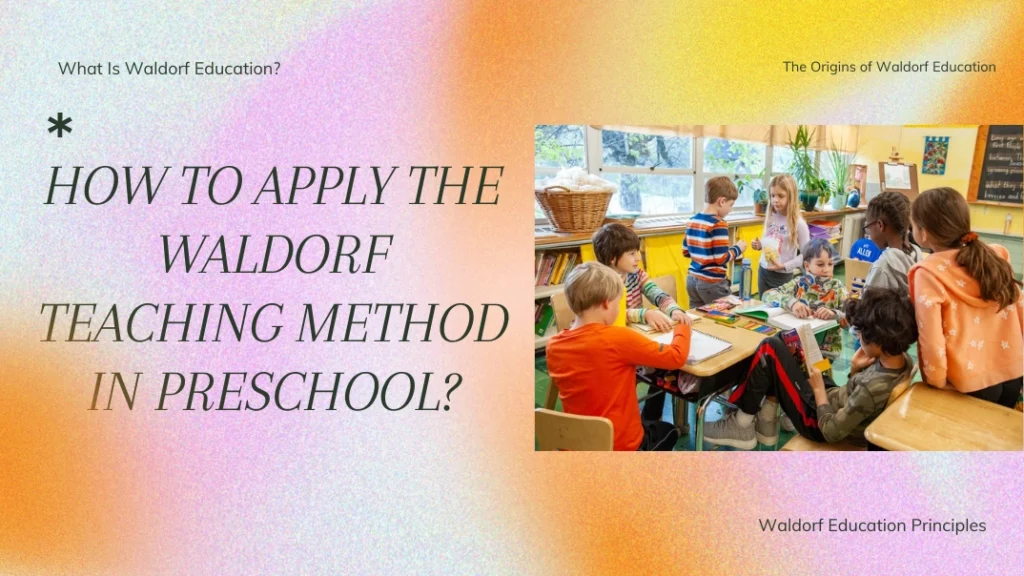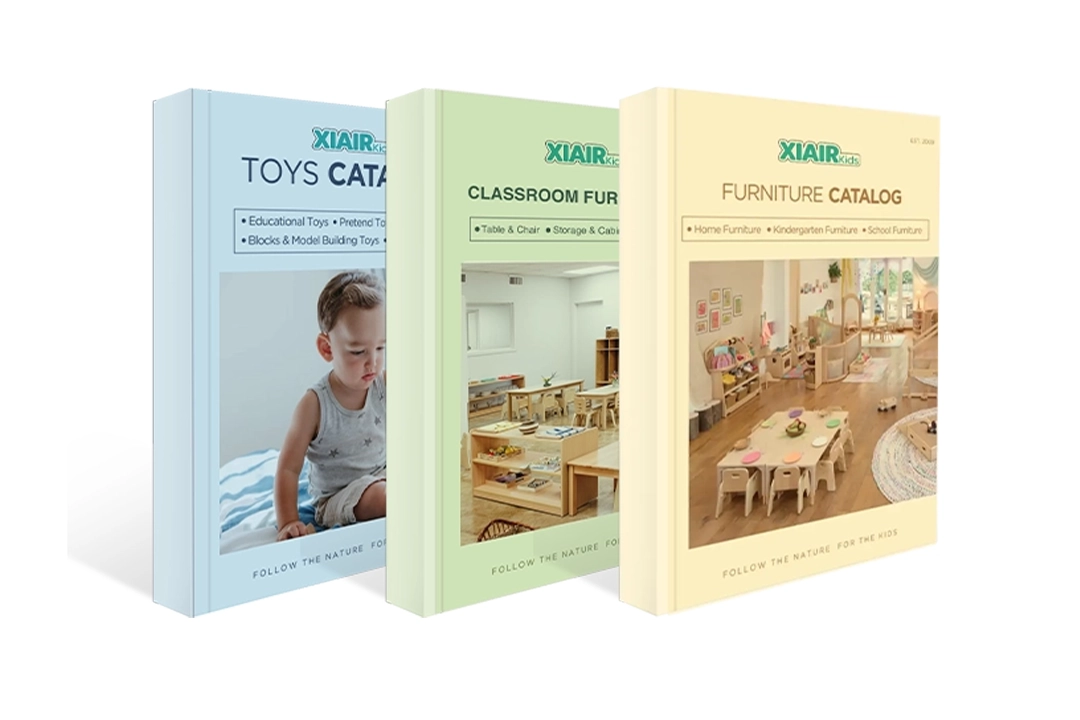발도르프 교수법은 전 세계적으로 상당한 지지를 받고 있으며, 특히 전인적 아동 발달을 중시하는 유치원 환경에서 더욱 그렇습니다. 하지만 발도르프 교수법은 정확히 무엇일까요? 발도르프 교육발도르프 교육과정을 유치원에서 효과적으로 적용할 수 있는 방법은 무엇일까요? 이 방법은 아이의 마음, 몸, 정신을 모두 발달시키는 데 중점을 두고 창의성, 독립심, 그리고 자연과의 연결을 강조하는 독특한 특징을 가지고 있습니다. 이 글에서는 발도르프 교육의 원리, 장단점, 그리고 이 방법론을 교실에 어떻게 접목할 수 있는지 살펴보겠습니다.
루돌프 슈타이너의 교육 철학에서 유래한 발도르프 교육법은 체험 학습, 창의력 함양, 그리고 자연과의 깊은 관계를 중시합니다. 발도르프 교육을 유치원에 접목함으로써 아이들은 학업적 준비를 갖추고 창의적인 사고를 하는 사람, 책임감 있는 사람, 그리고 평생 학습자로 성장합니다.
발도르프 교수법은 아동 학습에 더욱 균형 잡히고 총체적인 접근 방식을 제공함으로써 전통적인 교육과 차별화됩니다. 발도르프 교육법을 통해 아이들은 교과, 예술, 실기, 그리고 인성 발달을 아우르는 풍부한 학습 환경을 경험하게 됩니다. 하지만 교육자와 학부모는 발도르프 교수법을 실천하기 위해서는 핵심 원칙에 대한 헌신이 필요하다는 점을 이해해야 합니다.
그렇다면 발도르프 교육법은 전통적인 모델과 어떻게 다르며, 유아 교육 환경에 어떻게 접목될 수 있을까요? 먼저 발도르프 교육이 진정으로 무엇인지 살펴보겠습니다.
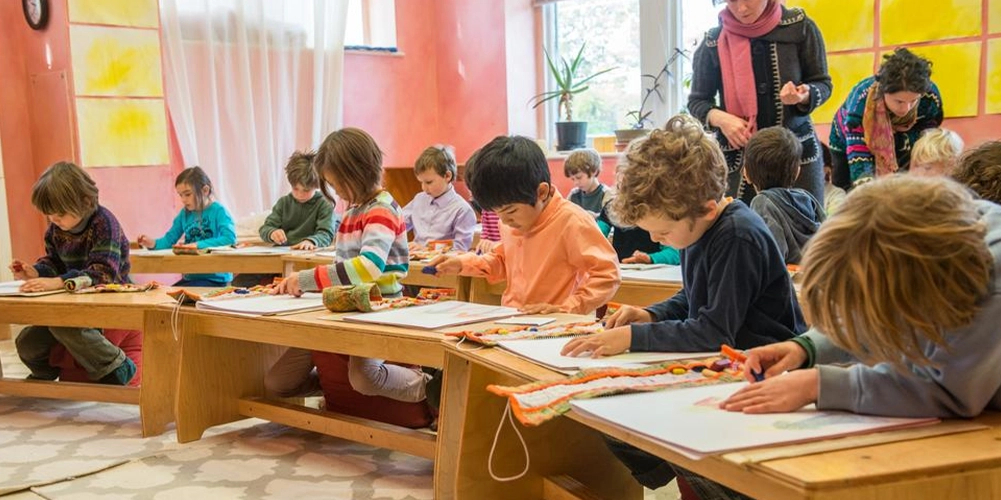
소개
발도르프 교육법은 창의적이고 아동 중심적인 학습 방식으로 잘 알려져 있습니다. 루돌프 슈타이너의 사상에 뿌리를 둔 발도르프 교육은 전 세계 학교와 유치원에서 실천되고 있습니다. 전통적인 교실 수업과 달리 발도르프 학교는 직접 체험하는 경험, 강한 리듬감, 그리고 자연과의 긴밀한 연결을 중시합니다. 이 독특한 교육 방식은 많은 부모와 교사들에게 각 아이의 자연스러운 성장과 학습에 대한 열정을 북돋아 줄 새로운 방법을 찾도록 영감을 주었습니다. 다음 부분에서는 발도르프 교육법을 특별하게 만드는 주요 사상과 원칙을 살펴보겠습니다.
발도르프 교육법: 기초와 핵심 원칙
발도르프 교수법은 아이들이 마음, 몸, 감정이 함께 지지될 때 가장 잘 배운다고 믿습니다. 루돌프 슈타이너가 시작한 이 접근법은 모든 아이를 고유한 존재로 보고, 성장하면서 각기 다른 단계를 거치게 합니다. 발도르프 교실에서는 놀이, 예술, 자연 탐험을 위한 충분한 시간을 통해 직접적이고 창의적인 학습이 이루어집니다. 꾸준한 일상과 계절의 리듬은 아이들이 안정감을 느끼도록 도와줍니다. 교사는 각 아이의 학습 속도를 존중하고 수업에 맞춰 수업을 조정합니다. 이처럼 간단하지만 강력한 아이디어는 발도르프 교수법을 기존 교육과 차별화합니다.
루돌프 슈타이너는 누구인가?
루돌프 슈타이너 발도르프 교육 운동의 창시자로 가장 잘 알려진 오스트리아의 철학자이자 사회 개혁가, 교육자 슈타이너는 교육이 아이의 정신, 신체, 정신의 모든 부분을 키워야 한다고 믿었습니다. 그의 사상은 현재 발도르프 교수법, 즉 슈타이너 교육으로 불리는 교육의 토대를 마련했으며, 이는 전 세계 여러 발도르프 학교에서 실천되고 있습니다. 인지학으로 알려진 슈타이너의 철학은 모든 발도르프 교육 원칙의 핵심입니다.
오늘날 슈타이너와 발도르프 교육은 긴밀히 연결되어 있습니다. 많은 발도르프 교사, 학부모, 그리고 학교들은 이 교육 방식의 고유한 특징을 더 잘 이해하기 위해 여전히 슈타이너의 강의와 저술을 연구합니다. 발도르프 시스템은 창의성, 개성, 그리고 세상과의 강한 유대감을 장려하는데, 이는 한 세기 전 루돌프 슈타이너가 처음 제시한 비전입니다.
슈타이너의 영향으로 발도르프 학교는 미국, 유럽, 아시아를 포함한 전 세계적으로 성장했습니다. 루돌프 슈타이너의 교육 철학, 즉 슈타이너 발도르프 접근법은 학문적 교과와 예술, 실천적 활동, 그리고 아동 발달에 대한 존중을 조화롭게 결합한 것으로 잘 알려져 있습니다.
발도르프 교육이란 무엇인가?
발도르프 교육은 발도르프 교수법 또는 슈타이너 교육이라고도 불리며, 아동의 전인적 발달에 초점을 맞춘 교육 방식입니다. 이 교육 방식은 발도르프 학교, 발도르프 유치원, 그리고 공립 발도르프 교육 프로그램에서도 사용됩니다. 발도르프 교육의 핵심은 아이들이 다양한 놀이, 미술, 음악, 그리고 직접 체험 활동을 통해 직접 체험하며 학습하도록 장려하는 것입니다.
발도르프 교실은 전통적인 학교와는 다른 모습과 분위기를 가지고 있습니다. 아이들이 자유롭게 탐구할 수 있는 나무 장난감, 천연 재료, 그리고 창의적인 공간이 마련되어 있습니다. 교육 과정은 자연스러운 유년기 단계를 따르며 각 아이의 학습 속도를 중시합니다. 이러한 독특한 학습 환경은 발도르프 교육학의 핵심 특징 중 하나이며, 발도르프 교육법을 다른 교육 시스템과 차별화하는 요소입니다.
발도르프 교육은 상상력, 실용적인 기술, 그리고 평생 지속되는 학습에 대한 열정을 강조하기 때문에 많은 가족들에게 매력적으로 다가갑니다. 발도르프 교육 철학은 일상, 리듬, 그리고 가정과 학교의 끈끈한 유대감을 중시합니다. 오늘날 전 세계적으로 수천 개의 발도르프 학교와 슈타이너 학교가 있으며, 각 학교는 아이들이 사려 깊고 자신감 넘치며 따뜻한 마음을 가진 어른으로 성장하도록 돕는 데 전념하고 있습니다.
꿈만 꾸지 말고, 직접 디자인하세요! 맞춤 가구에 대한 니즈를 함께 이야기 나눠요!
발도르프 교육의 기원
최초의 발도르프 학교는 1919년 독일 슈투트가르트에 있는 발도르프-아스토리아 담배 공장 노동자들의 자녀들을 위해 설립되었습니다. 루돌프 슈타이너는 학생들의 지적 능력과 예술적, 실용적, 도덕적 역량을 계발하는 교육 시스템을 구상했습니다. 발도르프 교육 시스템은 역동적이고 유연하게 설계되어 교사가 학생들의 발달 단계에 맞춰 수업을 구성할 수 있는 자유를 제공했습니다. 발도르프 교육 시스템의 목표는 사회에 의미 있게 기여할 수 있는 전인적 인재를 양성하는 것이었습니다.
슈타이너와 발도르프 교육은 그 이후 전 세계로 확장되어 현재 전 세계적으로 수천 개의 발도르프 학교가 운영되고 있습니다. 각 발도르프 학교는 학생들의 문화적, 지리적, 사회적 맥락에 맞춰 슈타이너의 교육 원리를 적용하여 발도르프 교육법을 실천합니다. 농촌이든 도시든 발도르프 교육과정은 학업적, 비학업적 활동을 통해 아동의 전인적 발달에 중점을 둡니다.
오늘날 발도르프 교육 학교는 여러 대륙에 걸쳐 유치원부터 고등학교까지 다양한 교육 과정을 제공하고 있습니다. 이 학교들은 루돌프 슈타이너가 제시한 원칙을 따르며 각 아동의 전인적 발달에 중점을 두고 있습니다.

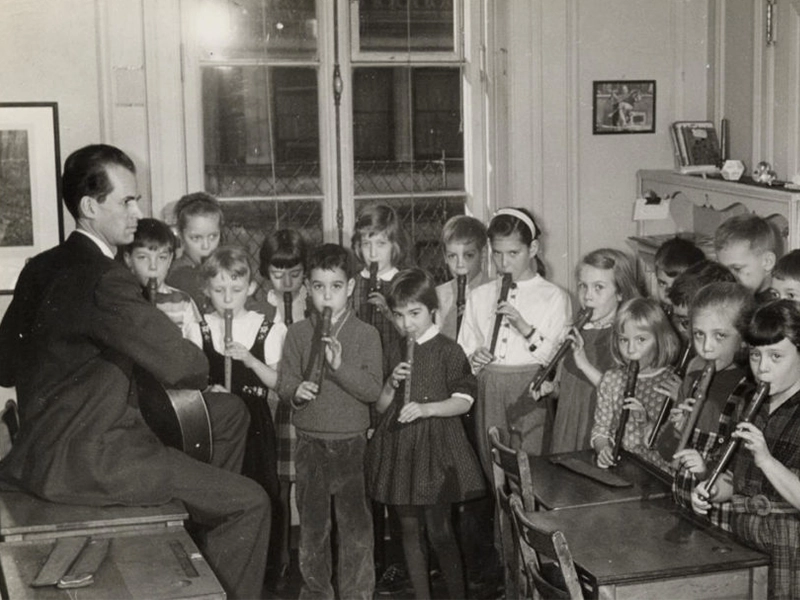
발도르프 교육의 기초
발도르프 교육은 아이들이 유아기, 중기 아동기, 청소년기라는 세 가지 뚜렷한 발달 단계를 거친다는 믿음에 기반을 두고 있습니다. 각 단계는 고유한 발달적 요구를 가지고 있으며, 발도르프 교육과정은 아이의 자연스러운 성장과 학습 능력을 지원하는 방식으로 이를 충족합니다.
유아기
발도르프 교육은 유아기에 놀이, 모방, 그리고 감각적 경험을 통한 학습에 중점을 둡니다. 발도르프 교실 환경은 의도적으로 단순하며, 나무 장난감과 털실과 같은 천연 재료로 채워져 있어 자연과의 교감을 촉진합니다. 발도르프 교육의 이 단계에서는 아이들이 요리, 청소, 정원 가꾸기와 같은 의미 있는 활동을 통해 신체와 감각을 발달시킬 수 있습니다.
발도르프 미취학 교육 과정의 중요한 측면은 다음과 같습니다.
- 창의적인 놀이: 놀이 기반 학습은 이 단계에서 발도르프 교육학의 초석입니다. 아이들은 창의력을 고취시키는 간단하고 자연스러운 장난감을 통해 상상력이 풍부한 놀이에 참여하도록 장려됩니다.
- 스토리텔링과 리듬: 구전 이야기, 노래, 시는 일상 활동의 중심이 되어, 어린이에게 안정감을 주는 리드미컬한 구조를 제공합니다.
- 실용적인 생활 기술: 어린이들은 빵 굽기, 교실 정리, 정원 가꾸기 등의 활동에 참여하는데, 이는 운동 능력을 개발하고 독립심을 키우는 데 도움이 됩니다.
발도르프 교육법은 이 시기에 아이들의 신체적, 정서적, 그리고 상상력을 키우는 데 중점을 둡니다. 아이들은 실제적인 과제와 놀이를 통해 세상을 경험하고 미래의 학업 학습에 필요한 기초적인 기술을 발달시킵니다. 이 단계의 발도르프 교실은 의도적으로 첨단 기기나 화면을 사용하지 않는데, 이는 아이들이 주변 환경과 더욱 직접적으로 소통해야 한다는 발도르프 교육 철학과 일맥상통합니다.
발도르프 유치원에서 교사는 아이들이 따라 할 수 있는 행동을 모델링하는 데 중요한 역할을 합니다. 이는 발도르프 교육법의 또 다른 기본 원칙을 강조합니다. 아이들은 어린 시절 직접적인 교육보다는 모범을 통해 가장 잘 배웁니다. 발도르프 교실은 종종 고요하고 양육적인 공간으로 묘사되며, 상상력 넘치는 놀이와 탐구를 장려합니다.
중년기
발도르프 학교에서 지적 학습은 중년기에 형성되기 시작합니다. 그러나 슈타이너의 철학에 따라 발도르프 교육 방식은 여전히 경험 학습과 예술적 표현을 지적 발달의 주요 수단으로 강조합니다.
이 단계의 발도르프 커리큘럼의 핵심 요소는 다음과 같습니다.
- 주요 레슨 블록: 수학, 문학, 과학과 같은 학문적 과목은 몇 주 동안 진행되는 집중 학습 블록으로 가르쳐지며, 이를 통해 학생들은 해당 주제에 완전히 몰입할 수 있습니다.
- 예술적 통합: 발도르프 교실의 모든 과목은 그림 그리기, 페인팅, 스토리텔링, 연극 등의 예술적 방법을 통해 가르쳐지며, 이를 통해 복잡한 아이디어를 더욱 구체적이고 관련성 있게 표현할 수 있습니다.
- 실습 활동: 발도르프 철학에 따라, 어린이들은 인지적, 신체적 기술을 통합하는 수공예 및 목공과 같은 실용적인 작업에도 참여합니다.
이 단계에서 발도르프 학교 철학은 창의성, 상상력, 협업을 강조하여 감성 지능 개발을 촉진합니다.
발도르프 교육법은 중기 아동기의 아이들의 정서적, 지적 발달을 돕고, 청소년기의 더욱 엄격한 학업적 요구에 대비할 수 있도록 돕습니다. 발도르프 학교 교사들은 같은 학생들과 수년간 함께하며, 끈끈하고 신뢰하는 관계를 형성하여 안정적인 학습 환경을 조성하는 것으로 알려져 있습니다. 이러한 연속성은 발도르프 교육 시스템의 중요한 특징으로, 학생들이 교사를 자주 바꾸는 기존 학교와 차별화됩니다.
발도르프 교육은 또한 중학생 시절의 야외 놀이와 자연과의 교감을 강조합니다. 아이들이 환경과 교감할 수 있도록 매일 야외 활동, 자연 산책, 현장 학습이 발도르프 교육과정에 통합되어 있으며, 이는 발도르프 학교의 핵심 가치를 더욱 잘 반영합니다.
청년기
아이들이 청소년기에 접어들면서 발도르프 교육과정은 비판적 사고, 윤리적 성찰, 그리고 사회적 책임감을 함양하는 방향으로 전환됩니다. 이 시기의 발도르프 학교는 자율 학습, 공동체 참여, 그리고 개인의 관심사 추구를 강조합니다.
이 단계의 주요 측면은 다음과 같습니다.
- 비판적 사고: 청소년들은 추론 및 반성 능력을 개발하기 위해 철학적 토론, 연구 프로젝트, 분석 과제에 참여하도록 권장됩니다.
- 봉사 학습: 발도르프의 원칙에 따라 학생들은 사회적 책임과 윤리 의식을 강조하는 지역 사회 봉사 프로젝트에 참여합니다.
이 단계에서 발도르프 교수법은 청소년들이 공동체와 더 넓은 세상에서 자신의 역할을 이해하도록 돕습니다. 발도르프 교사는 멘토 역할을 하며, 학생들이 독립심과 강한 목적의식을 키울 수 있도록 지원합니다.
~ 안에 발도르프 학교청소년기는 자아 발견과 개인적 성장의 시기입니다. 발도르프 교육과정은 학생들에게 지적인 도전과 정서적인 자극을 제공하여 공감 능력과 사려 깊음을 갖춘 사람으로 성장하고 사회에 긍정적으로 기여할 수 있도록 설계되었습니다. 전 세계 발도르프 교육 학교들은 학생들이 단순한 학업 성취를 넘어 전인적인 교육을 받고 졸업할 수 있도록 이러한 원칙들을 지속적으로 실천하고 있습니다.
당신에게 딱 맞는 교실을 클릭 한 번으로 만나보세요!
발도르프 교육 원칙
발도르프 교육 철학은 몇 가지 핵심 원칙으로 정의됩니다. 이러한 원칙은 교사가 학생과 소통하고 전인적 학습 경험을 촉진하기 위한 교육 과정을 구성하는 방식에 영향을 미칩니다.
영적인 존재로서의 인간
발도르프 교육학의 핵심 신념 중 하나는 아이들이 고유한 운명을 가진 영적인 존재라는 것입니다. 발도르프 교육법은 종교적 의미가 아니라, 삶에 대한 경외심과 경외심을 함양함으로써 아이들의 영적 발달을 장려합니다. 발도르프 교실은 자연 재료의 아름다움, 계절의 리듬, 그리고 예술적 표현을 통해 경외심을 불러일으키도록 설계되었습니다.
발도르프 교육법은 자연의 리듬과 밀접하게 연관되어 있으며, 매일, 매주, 그리고 계절의 리듬은 어린아이들에게 예측 가능하고 안전한 환경을 조성하는 데 도움을 줍니다. 예를 들어, 발도르프 유치원에서는 노래, 시, 그리고 계절별 활동을 통해 아이들이 시간의 자연스러운 흐름에 공감하도록 돕습니다. 발도르프 교육의 영적인 측면은 각 아이의 고유한 잠재력과 자아감을 발달시키는 데 중점을 두어, 공감 능력이 뛰어나고 사회적으로 책임감 있는 사람으로 성장하도록 돕습니다.
가르치는 것의 자유
발도르프 시스템에서는 교사에게 수업 진행에 있어 상당한 자유가 부여됩니다. 발도르프 교육 방식은 교육자가 학생들의 필요와 관심사에 맞춰 교육 과정을 조정할 수 있도록 하여 학습이 흥미롭고 관련성 있게 진행되도록 보장합니다. 이러한 창의적 자유는 발도르프 학교를 전통적인 교육 시스템과 차별화합니다. 전통적인 교육 시스템은 엄격한 교육 과정으로 인해 개별 학습 경험이 제한될 수 있기 때문입니다.
발도르프 교사는 아이들의 호기심과 창의력을 고취하는 수업을 만들 수 있는 자율권을 부여받습니다. 교사는 아이들의 발달 과정을 관찰하여 수업 내용과 방법을 결정합니다. 이러한 자유 덕분에 발도르프 학교 교사는 각 아이에게 맞는 학습 경험을 맞춤화하여 교육을 표준화된 과정이 아닌 유기적이고 점진적으로 발전시키는 과정을 가능하게 합니다.
발도르프 교육법은 교사가 교육자이자 창의적인 안내자라는 역할을 중시하며, 학생들이 자신의 관심사와 재능을 탐구하도록 격려하는 역동적이고 반응성 있는 학습 환경을 조성합니다.
체험 학습 및 관계 구축
발도르프 교육은 아이들이 직접 참여하는 활동을 통해 교과목에 참여하는 체험 학습을 중시합니다. 그림 그리기, 정원 가꾸기, 스토리텔링 등 발도르프 교실의 학생들은 직접 체험하며 배웁니다. 또한, 교사와 학생 간의 긴밀한 관계는 발도르프 교육의 또 다른 특징입니다. 교사는 종종 같은 학생들과 수년간 함께하며 학습 경험을 풍부하게 하는 깊은 유대감을 형성합니다.
발도르프 교수법은 교실 내에서 형성되는 관계를 매우 중요하게 생각합니다. 같은 교사가 여러 해 동안 학생들을 지도하는 것은 강한 신뢰와 이해의 유대감을 형성하여, 학생들이 안전하게 자신을 표현하고 학습 과정에서 위험을 감수할 수 있는 지지적인 환경을 조성합니다. 이러한 연속성은 발도르프 교육 시스템에 필수적이며, 아이의 학교 생활 전반에 걸쳐 안정감과 정서적 안정감을 증진합니다.
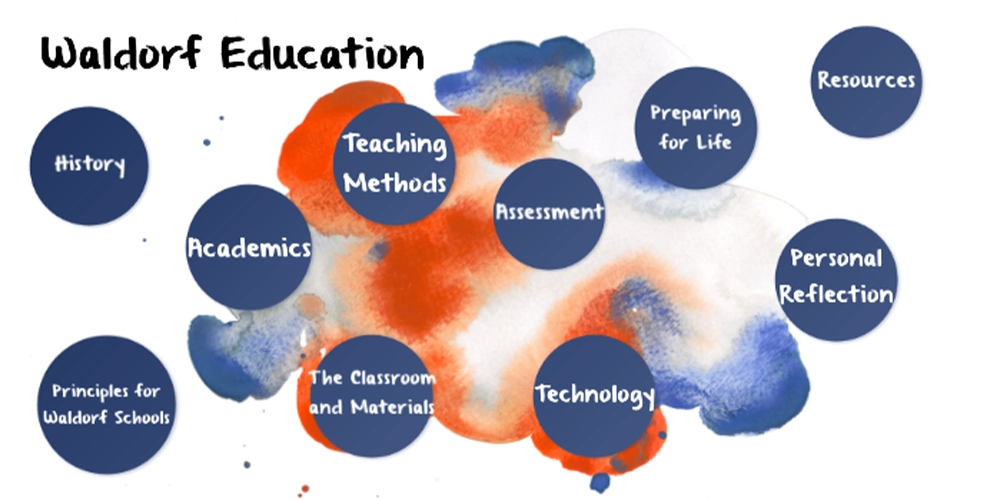
발도르프 교육법의 장단점
유치원 환경에서 발도르프 교육 시스템을 고려할 때, 그 강점과 잠재적 어려움을 평가하는 것이 필수적입니다. 아래에서는 발도르프 교육 방식의 장단점을 종합적으로 살펴보겠습니다.
장점:
- 학습은 실습적이고 연령에 적합합니다.
발도르프 교육법은 체험적이고 촉각적인 학습을 강조하여, 어린이가 자신의 발달 단계에 맞는 활동에 참여할 수 있도록 합니다. - 학습은 놀이 기반입니다
놀이는 발도르프 유치원의 학습에 중요한 측면으로, 창의성, 인지 발달, 사회성을 증진시킵니다. - 기술은 교실에서 사용되지 않습니다.
발도르프 교육 모델은 의도적으로 기술 사용을 최소화하여 아이들이 주변 세계와 직접 소통하도록 장려합니다. - 학생들은 교육에 적극적으로 참여하는 방법을 배웁니다.
발도르프 교육법은 아이들이 자기 주도적 학습자가 되도록 장려하고, 독립심과 호기심을 키워줍니다. - 발도르프 학교는 전인적 재능을 갖춘 개인을 양성합니다.
발도르프 교육의 전체론적 접근 방식은 지적, 정서적, 예술적 능력의 발달을 지원하여 어린이가 전인적인 개인으로 성장하는 데 도움이 됩니다. - 발도르프 교육을 받은 사람들은 평생 학습에 대한 열정을 가지고 있습니다.
발도르프 학교 졸업생들은 종종 평생 학습에 대한 깊은 사랑을 유지하는데, 이는 발도르프 철학이 호기심과 경이감을 심어주기 때문입니다.
단점:
- 학업에 대한 집중력 부족
- 발도르프 교육을 비판하는 사람들은 독서와 수학과 같은 공식적인 학문의 도입이 늦어지면 학생들이 전통적인 환경의 학생들에 비해 불리한 입장에 놓일 수 있다고 주장합니다.
- 교사들은 같은 아이들을 여러 해 동안 가르칩니다.
- 이런 방식은 강력한 관계를 촉진하는 반면, 학생들이 다양한 교육 스타일과 관점을 접하는 데 제한이 될 수 있습니다.
- 기술의 제한된 사용
- 많은 부모가 발도르프 교육의 기술 없는 접근 방식을 높이 평가하지만, 일부 부모는 이 방식이 학생들이 기술 중심 세상에 대비하지 못하게 만들 수 있다고 생각합니다.
발도르프 교육 학교들은 교실에 기술을 도입하는 데 소극적이라는 비판을 자주 받습니다. 이는 더 깊은 개인적이고 창의적인 참여를 촉진하기 위한 것이지만, 일부 학부모와 교육자들은 발도르프 학교 아이들이 현대 사회에 필요한 디지털 리터러시 능력을 개발하지 못할 수 있다고 우려합니다. 그럼에도 불구하고, 발도르프 교수법 지지자들은 발도르프 학교에서 창의성과 문제 해결 능력에 중점을 두는 것이 학생들이 미래의 도전에 충분히 대비할 수 있도록 돕는다고 주장합니다.
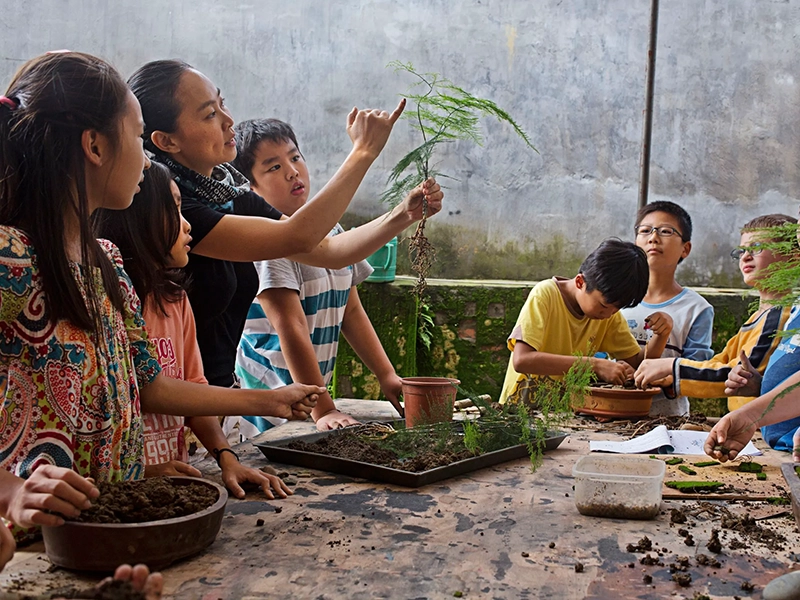
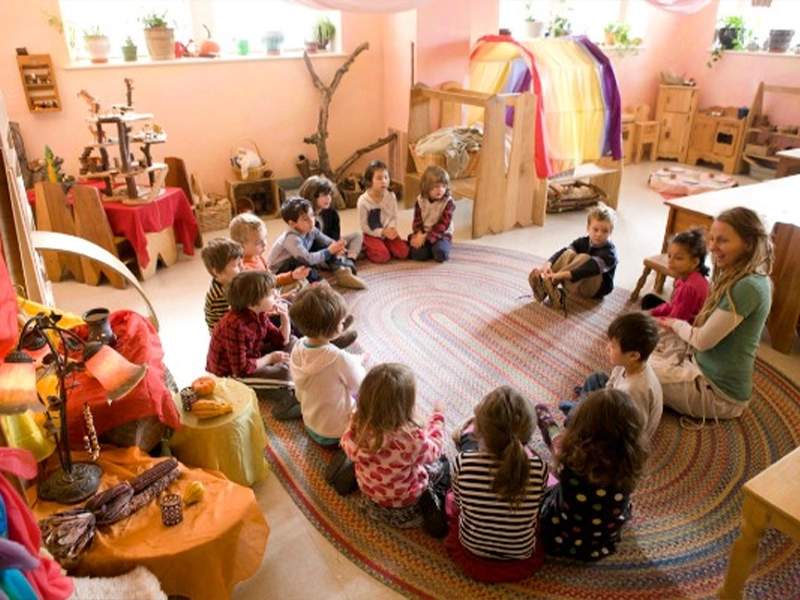
발도르프에서 영감을 받은 학습 환경 만들기
발도르프 교육법의 핵심을 반영하도록 세심하게 설계된 발도르프 교실은 벽의 색상부터 가구 선택까지 모든 디테일이 아이들의 학습과 웰빙을 지원하는 데 중요한 역할을 합니다. 발도르프 교육이 진정으로 발전할 수 있는 공간을 만드는 데 가장 중요한 요소들을 살펴보겠습니다.
발도르프 교육에서 교실 환경이 중요한 이유
발도르프 교육법에서는 교실 환경 학습 과정의 연장선으로 여겨집니다. 발도르프 학교는 아이들이 단순히 배우는 것 이상을 흡수한다는 것을 이해합니다. 아이들은 매일 주변 환경에 깊은 영향을 받습니다.
- 교실은 "제3의 교사"입니다.
발도르프 교육에서 실제 교실은 단순한 배경이 아니라 교사진의 적극적인 참여를 이끌어냅니다. 공간은 아이들의 행동과 사고방식을 부드럽게 이끌어줍니다. 발도르프 교실이 의도적으로 구성되면 자연스럽게 학생들의 집중력, 창의력, 그리고 협력을 증진시킵니다. 이것이 많은 발도르프 학교들이 신중하게 계획된 배치, 은은한 조명, 그리고 깔끔한 공간에 투자하는 이유입니다. - 차분하고 매력적인 공간:
발도르프 교실은 시끄러운 색깔이나 강렬한 조명을 지양합니다. 대신 은은한 색조와 자연광, 그리고 조용한 구석이 많습니다. 이러한 환경은 아이들이 안전하고 편안함을 느끼도록 돕고, 이는 아이들이 탐구하고, 질문하고, 새로운 것을 시도하도록 장려합니다. 차분한 환경은 발도르프 교육의 특징이며, 발도르프 교육 방식의 성공과 밀접한 관련이 있습니다. - 움직임과 유연성:
발도르프 교실은 기존 교실과 달리 고정되어 있지 않습니다. 가구를 옮겨서 그룹 활동, 동아리 활동, 또는 상상력이 풍부한 놀이를 위한 공간을 만들 수 있습니다. 유연한 교실 배치는 자립심과 협동심을 모두 향상시킵니다. 아이들은 교실 정리에 참여하며, 이를 통해 발도르프 교육 학교의 핵심 가치인 책임감과 공유 공간에 대한 존중을 배우게 됩니다. - 감각과의 연결:
울 러그의 질감부터 나무 선반의 향기까지, 모든 요소는 아이들의 감각 발달을 돕기 위해 선택되었습니다. 발도르프 학습법은 교사가 촉각과 상호작용을 유도하는 재료를 사용하도록 권장합니다. 이러한 감각적 경험은 아이들이 현재 순간에 집중하고 주변 환경과 연결되어 있음을 느끼도록 도와줍니다. - 발도르프 커리큘럼 지원:
세심하게 설계된 교실은 발도르프 교육과정의 모든 측면을 지원합니다. 아늑한 구석에서 이야기를 나누든, 햇살 가득한 테이블에서 그림을 그리든, 아침 노래를 부르며 함께 시간을 보내든, 이러한 환경은 모든 학습 경험을 더욱 풍요롭게 합니다. 발도르프 교수법은 아이들이 수업 자체만큼이나 교실 환경이 따뜻하고 영감을 줄 때 성장한다는 것을 일깨워줍니다.
발도르프 교실에 적합한 재료와 가구 선택
선택 올바른 가구 진정한 발도르프 교실을 만드는 데 있어 재료와 재료는 핵심 요소입니다. 선생님의 선택은 학교의 모습과 분위기뿐만 아니라 아이들이 매일 배우고 소통하는 방식까지 형성할 것입니다.
- 발도르프 디자인의 핵심인 천연 소재:
발도르프 학교와 유치원은 가구와 교실 용품으로 나무, 양모, 면과 같은 천연 소재를 선호합니다. 원목 의자, 어린이용 테이블, 천연 원목 선반이 흔히 사용됩니다. 이러한 가구들은 내구성과 안전성을 제공할 뿐만 아니라, 아이들이 자연과 교감하는 데 도움을 주는데, 이는 발도르프 교육 철학의 핵심 가치입니다. 양모 러그, 면 커튼, 손으로 짠 바구니도 흔히 볼 수 있습니다. - 어린이용 및 인체공학적 가구:
발도르프 교육법은 독립성을 중시하기 때문에 가구는 아이의 눈높이에 맞춰 선택해야 합니다. 낮은 탁자, 작은 나무 의자, 열린 책장, 그리고 아이 키에 맞는 옷걸이를 선택하세요. 인체공학적 디자인은 발도르프 교육에 필수적인 바른 자세와 건강한 움직임을 지원합니다. - 단순성과 다양성:
발도르프 교실에서는 가구와 재료를 단순하게 사용하여 자유로운 놀이를 장려합니다. 놀이 스탠드(실크 천을 걸거나 상상력이 풍부한 장면을 연출하는 나무 틀)는 인형극장, 가게, 또는 독서 공간으로 활용할 수 있습니다. 미술 이젤, 블록을 쌓을 수 있는 큰 바구니, 쌓을 수 있는 의자는 모두 다양한 용도로 활용 가능하며 발도르프 학습 방식을 뒷받침합니다. - 안전 및 지속 가능성:
안전은 항상 최우선입니다. 발도르프 교육 학교는 매끄러운 모서리, 안정적인 바닥, 무독성 마감재를 사용한 가구를 선택합니다. 발도르프의 지구 존중 원칙에 부합하는 지속 가능한 생산 또한 필수적입니다. 친환경적인 제품을 고려하세요. 나무 가구교실에 사용할 대나무 보관 선반이나 FSC 인증 제품을 찾아보세요. - 미적 조화:
발도르프 교실의 모든 물건은 아름다움과 질서를 유지하도록 선택됩니다. 조화로운 색상, 부드러운 원단, 그리고 자연스러운 질감은 평화로운 분위기를 조성합니다. 울 소재의 바닥 러그, 면 쿠션, 그리고 자연에서 영감을 받은 장식 소품들이 교실 곳곳에 배치되어 있습니다.
발도르프 교실을 위한 제품 체크리스트
| 제품 유형 | 설명/사용 | 발도르프 특징 |
|---|---|---|
| 어린이용 나무 테이블 | 그룹 활동, 식사, 미술 활동 등을 위해 | 천연 소재, 인체공학적 디자인 |
| 나무 의자 | 올바른 자세와 독립성을 지원합니다 | 튼튼하고, 어린이용 크기로 이동이 편리합니다. |
| 오픈 선반/책장 | 책, 장난감, 교실용품 보관 | 낮은 높이로 접근이 편리하며, 천연 목재 사용 |
| 놀이 스탠드 / 인형극장 | 상상력이 풍부한 놀이와 장면 창조를 위해 | 다재다능하고 창의성을 북돋아줍니다 |
| 미술용 이젤 및 공예용 테이블 | 그림, 드로잉, 공예 | 조절 가능, 청소가 쉬움 |
| 대형 짠 바구니 | 블록, 장난감, 미술용품 정리하기 | 부드럽고 천연 섬유로 사용성이 유연함 |
| 울 또는 코튼 러그 | 그룹 공간과 독서 코너를 정의하세요 | 부드러운 질감, 자연스러운 색상 |
| 바닥 쿠션 및 빈백 | 아늑하고 매력적인 독서 공간이나 휴식 공간을 만들어 보세요. | 편안하고 안전한 소재 |
| 자연 테이블/진열 선반 | 계절별 상품과 자연 컬렉션을 보여주세요 | 교실과 자연을 연결하다 |
| 어린이 높이에 맞는 옷걸이 | 독립성과 질서를 육성하다 | 셀프 케어에 적합한 높이 |
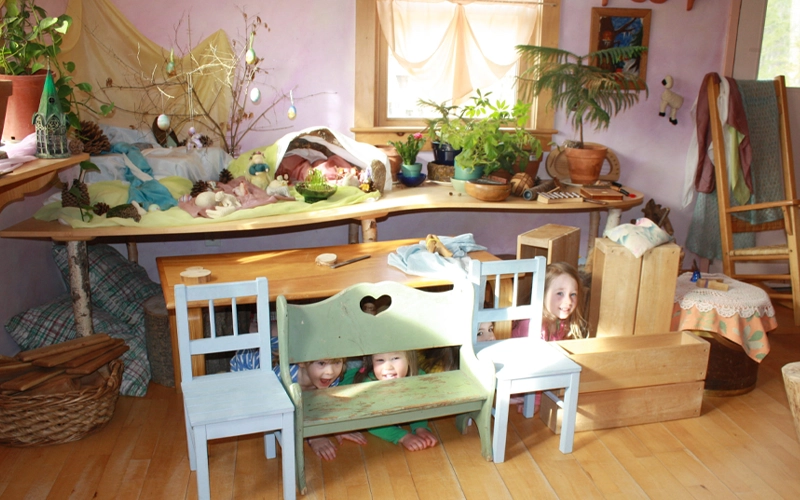
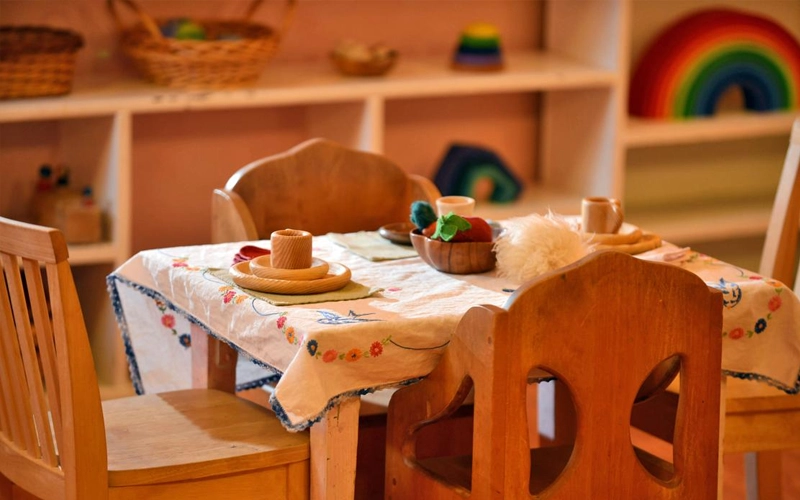

개방형 놀이 및 학습 공간 설계
발도르프 교수법의 핵심 특징은 자유로운 놀이와 직접 체험하는 탐구를 위한 공간을 마련하는 것입니다. 발도르프 교실에서 교사는 상상력과 사회성 발달을 장려하기 위해 사려 깊은 구성과 다양한 활용 자료를 활용합니다.
- 상상력이 풍부한 놀이를 위한 유연한 공간:
발도르프 학교는 놀이 스탠드를 효과적으로 활용하는데, 실크 스카프나 천 조각 몇 개만으로도 가게, 극장, 또는 아늑한 은신처로 활용할 수 있습니다. 나무 블록, 쌓기 상자, 그리고 간소한 테이블은 아이들이 자신만의 놀이 세계를 디자인할 수 있도록 도와줍니다. - 간단하고 다용도로 활용 가능한 소재:
발도르프 교실에서 장난감과 소품은 다재다능함을 고려하여 선택됩니다. 발도르프 인형, 나무 동물, 엮은 바구니, 펠트 매트, 실크 스카프는 아이들이 스스로 이야기를 만들고, 무대를 꾸미고, 움직임을 탐구할 수 있도록 도와줍니다. 이는 '실천을 통한 학습'이라는 발도르프 철학을 뒷받침합니다. - 화면이나 배터리 장난감 금지:
발도르프 교육법에 따라 교실에는 전자 기기가 없습니다. 대신 아이들은 나무 퍼즐, 자연에서 영감을 받은 물건, 그리고 창의적인 공예 용품을 활용하여 깊이 있는 활동을 즐깁니다. - 다양한 활동을 위한 구역:
공간은 다양한 용도로 마련되어 있습니다. 바닥 쿠션과 낮은 책장이 있는 독서 공간, 나무 조각과 낱개 부품 바구니가 있는 건축 공간, 페인트와 점토가 있는 미술 테이블, 스토리텔링을 위한 인형 무대 등이 있습니다. - 사회적, 정서적 성장 촉진:
이러한 개방형 자원을 통해 어린이는 자연스럽게 협력하고, 공유하고, 소통하는 법을 배우게 되는데, 이는 발도르프 교육의 특징입니다.
전형적인 발도르프 놀이 및 학습 제품:
| 제품 | 교실에서의 사용 |
|---|---|
| 플레이 스탠드 | 요새, 상점, 인형극장 건설 |
| 나무 블록 | 창의적 구성, 계산 및 분류 |
| 실크 스카프 및 원단 | 상상력이 풍부한 놀이를 위한 의상, 움직임, 풍경 |
| 발도르프 인형과 꼭두각시 | 스토리텔링, 롤플레잉, 사회적 학습 |
| 짠 바구니 | 장난감, 자연물, 미술용품 보관 |
| 바닥 쿠션 및 러그 | 독서, 휴식, 모임을 위한 아늑한 공간 |
| 미술용 이젤 및 공예용 테이블 | 그림 그리기, 드로잉, 협업 프로젝트 |
| 낮은 선반 및 책장 | 어린이를 위한 접근 가능한 보관 공간, 책 전시 |
| 나무 조각 및 느슨한 부분 | 빌딩, 스태킹, 자연 기반 탐험 |
이러한 개방형 제품은 발도르프 교육법을 현실에 적용하여 모든 교실을 창의성, 독립성, 발견이 일상 생활의 일부가 되는 장소로 바꾸는 데 도움이 됩니다.

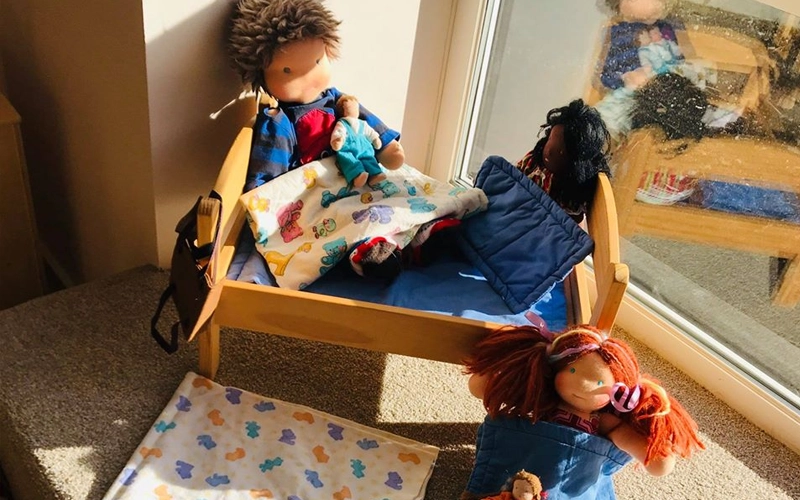

자연과 계절의 리듬을 교실로 가져오기
발도르프 교육법은 아이들을 자연과 연결하고 계절의 리듬을 존중하는 데 중점을 둡니다. 발도르프 교실 환경은 발도르프 교육학과 철학의 핵심인 자연의 순환을 반영하도록 세심하게 설계되었습니다.
- 자연 테이블과 계절별 디스플레이:
발도르프 학교와 발도르프 교육 유치원에서는 자연 테이블이 핵심 요소입니다. 아이들은 돌멩이, 나뭇잎, 꽃 등 계절에 맞는 물건들을 수집하고 전시하며, 교실을 자연의 변화를 생생하게 보여주는 공간으로 탈바꿈시킵니다. 이러한 체험 활동은 발도르프 교육법의 특징이며, 지구에 대한 관찰과 존중을 장려함으로써 발도르프 학습 방식을 뒷받침합니다. - 자연광과 식물 생명 극대화:
전형적인 발도르프 교실은 햇살과 신선한 공기로 가득 차 있어 아이들의 웰빙과 학습에 도움을 줍니다. 발도르프 교육 학교에서는 식물과 실내 정원을 흔히 볼 수 있으며, 이는 학생들이 생물을 돌보는 법을 배우는 데 도움이 됩니다. 발도르프 학교 교사들은 창문 크리스털이나 선캐처를 사용하여 공간에 자연의 색과 아름다움을 불어넣습니다. - 계절별 공예품과 자연 장식:
발도르프 교육과정에는 양모, 펠트, 나무를 활용한 다양한 수공예 활동이 포함됩니다. 아이들은 봄 화환이나 가을 모빌처럼 각 계절을 기념하는 장식과 미술 작품을 만듭니다. 이러한 창의적인 활동은 발도르프 수업의 핵심이며, 발도르프 교실의 리듬을 형성하는 데 도움이 됩니다. - 야외 학습 및 자연 산책:
발도르프 교육 방식은 학교 정원이나 자연 산책 등 규칙적인 야외 활동을 장려합니다. 이러한 경험은 발도르프 교육 시스템에 깊이 통합되어 아이들이 직접적인 경험을 통해 배우고 발도르프 교수법의 가치를 강화하도록 돕습니다. - 일일 및 주간 리듬:
발도르프 교육 철학을 따르는 교사들은 자연의 리듬에 맞춰 일상과 계절 축제를 계획합니다. 아침 모임, 매주 베이킹, 계절별 행사는 모두 발도르프 교육 시스템이 실제로 적용된 대표적인 사례입니다.
모든 발도르프 교실에는 이러한 자연스러운 요소와 리듬이 배움에 생동감을 불어넣습니다. 발도르프 교육법은 아이들이 주변 세상을 인식하고 더 큰 무언가의 일부임을 느끼도록 가르칩니다. 이는 발도르프 교육의 고유한 특징 중 핵심적인 부분입니다.
당신에게 딱 맞는 교실을 클릭 한 번으로 만나보세요!
레이아웃을 통한 독립성과 창의성 지원
발도르프 교수법의 핵심 목표는 아이들이 독립적인 사고와 창의적인 문제 해결 능력을 갖추도록 돕는 것입니다. 발도르프 교실의 구성 방식은 모든 아이의 독립성과 창의성을 키우는 데 큰 도움이 될 수 있습니다.
- 접근 가능한 가구 및 자재:
발도르프 학교에서는 모든 테이블, 의자, 선반, 수납장이 어린이에게 편안한 높이로 설치되어 있습니다. 이를 통해 아이들은 필요한 물건을 찾고, 활동 후 정리 정돈을 하고, 하루 종일 스스로 선택하도록 장려됩니다. 발도르프 교실은 발도르프 교육 철학의 핵심 원칙인 아이들의 자존감을 향상시키고 자신감을 키우도록 설계되었습니다. - 자유로운 이동을 위한 오픈 레이아웃:
발도르프 교육법은 명확한 동선이 있는 개방적인 공간을 권장합니다. 가구는 아이들이 놀이 공간, 독서 공간, 미술 테이블 등 활동 공간을 자유롭게 이동할 수 있도록 배치됩니다. 이러한 자유는 발도르프 교육에서 중시하는 창의적인 탐구, 협력, 그리고 신체 협응력을 향상시킵니다. - 선택과 유연성:
발도르프 교육 방식은 아이들이 어디서 어떻게 놀고 공부할지 스스로 선택할 수 있도록 합니다. 독서를 위한 조용한 구석, 그룹 미술 활동을 위한 큰 테이블, 조립을 위한 열린 공간 등 다양한 공간을 마련함으로써 학생들은 자신의 관심사를 추구하고 개성을 표현할 수 있습니다. 이는 발도르프 교육 방식의 고유한 특징을 뒷받침합니다. - 자기 주도 활동:
발도르프 교육 모델을 사용하는 교사들은 자기 주도적인 프로젝트와 자유로운 활동을 장려합니다. 자료는 아이들이 스스로 활동을 시작하고 활동을 마친 후 정리할 수 있도록 체계적이고 보기 좋게 진열되어 있습니다. 이러한 활동 루틴은 학생들이 교실에서 책임감과 주인의식을 기르는 데 도움이 됩니다. - 협업 장려:
독립성이 중요하지만, 이러한 구성은 팀워크를 촉진하기도 합니다. 그룹 좌석, 공유 자료, 그리고 동아리 활동이나 공연을 위한 열린 공간은 학생들이 함께 작업하고, 아이디어를 공유하고, 집단적으로 문제를 해결할 수 있는 기회를 제공합니다. 이는 발도르프 교육 시스템의 핵심적인 측면입니다.
발도르프 교육법은 사려 깊은 교실 배치를 통해 어린이들이 생활 기술, 자기 동기 부여, 창의적 자신감을 키울 수 있는 환경을 조성합니다. 이러한 자질은 미취학 아동기를 훨씬 넘어서까지 지속됩니다.
야외 학습 공간 통합
발도르프 교육법에서는 학습이 교실 문 앞에서 끝나지 않습니다. 야외 공간은 발도르프 학교 환경의 중요한 연장선으로 여겨지며, 아이들에게 신선한 공기와 활동, 그리고 자연과 교감할 수 있는 무한한 기회를 제공합니다.
- 자연을 염두에 두고 야외 교실을 설계하세요
발도르프 교육 학교들은 종종 정원, 모래 구덩이, 또는 조용한 야외 공간을 조성합니다. 나무 벤치, 나무 그루터기, 대나무 울타리와 같은 천연 재료를 사용하여 야외 공간이 발도르프 철학과 조화를 이루도록 합니다. - 계절별 활동 계획
자연 산책, 정원 가꾸기, 계절별 행사를 위한 시간을 계획하세요. 아이들은 봄에는 구근을 심고, 가을에는 낙엽을 모으고, 겨울에는 눈으로 요새를 쌓을 수 있습니다. 야외 학습은 발도르프 교육에서 매우 중요한 리듬감과 감각적 경험을 지원합니다. - 외부에서 개방형 놀이 자료 제공
통나무, 돌, 나뭇가지, 밧줄과 같은 조립 및 탐험 활동을 위한 느슨한 구성품을 제공합니다. 플라스틱 놀이기구는 피하세요. 자연 소재는 발도르프 교육 방식에 더 적합하며 창의성을 북돋아 줍니다. - 보호된 공간 만들기
아이들이 날씨에 상관없이 밖에서 배우고 놀 수 있도록 그늘진 공간이나 간이 야외 쉼터를 마련해 주세요. 야외 칠판, 낮은 탁자, 자연 미술 공간은 야외 수업에 다양성을 더합니다. - 탐사 및 독립 지원
발도르프 교육에서 야외 학습은 아이들에게 탐구할 자유를 주는 것입니다. 안전한 경계, 눈에 띄는 교사, 그리고 간단한 기본 원칙은 아이들이 위험을 감수하고 자신의 속도에 맞춰 학습할 수 있도록 합니다. - 발도르프 커리큘럼을 야외로 확장
많은 발도르프 학교는 실내 활동을 야외로 확장합니다. 아침 모임, 이야기 나누기, 그림 그리기, 심지어 간식 시간까지 야외에서 진행할 수 있습니다. 이러한 확장은 발도르프 교육법의 고유한 특징을 더욱 강화합니다.
야외 학습 공간을 신중하게 통합하면 어린이가 잘 자라나고, 아동 전체의 발달을 지원하며, 학교나 유치원에서 발도르프 교육 방법을 실제로 적용할 수 있습니다.
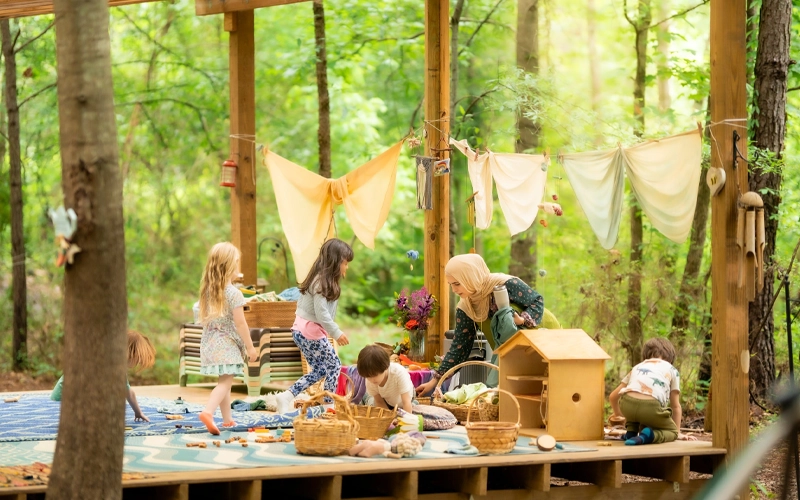
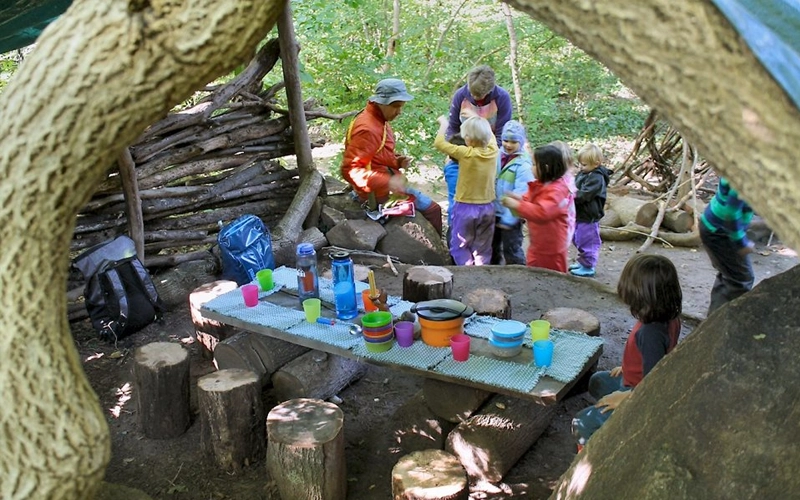
발도르프에서 영감을 받은 교실을 꾸미기 위한 실용적인 팁
발도르프 교실을 꾸미는 것은 단순히 아름다운 가구를 고르는 것 이상의 의미를 지닙니다. 발도르프 교육법은 각 아이의 정신, 신체, 그리고 영혼의 성장을 지원하는 환경을 조성하는 데 중점을 둡니다. 발도르프 교육 교실이나 유치원을 준비하는 모든 분들을 위한 몇 가지 실용적인 제안을 소개합니다.
- 명확한 계획으로 시작하세요:
가구를 들여오기 전에 발도르프 교실을 하루 종일 어떻게 활용할지 결정하세요. 하루와 계절의 리듬, 그룹 활동, 조용한 공간, 그리고 활동 공간을 고려하세요. 발도르프 교육은 유연성과 흐름을 중시합니다. - 천연 소재를 우선시하세요:
견고한 원목 테이블과 의자, 면이나 양모 러그, 그리고 천연 섬유 커튼을 선택하세요. 이러한 소재는 발도르프 학교 환경을 차분하고 따뜻하며 건강하게 만들어 줍니다. 발도르프 교육 철학을 지키기 위해 가능하면 플라스틱이나 금속 소재는 피하세요. - 정의된 영역 만들기:
선반과 가구를 활용하여 교실을 놀이, 미술, 독서, 그리고 모둠 활동 공간으로 구분하세요. 발도르프 교육법에서는 명확한 구역을 설정하는 것이 발도르프 학습법의 고유한 특성을 뒷받침합니다. - 장식을 단순하고 리드미컬하게 유지하세요:
어수선하고 과감한 장식은 피하세요. 대신 계절별 공예품, 자연 친화적인 테이블, 그리고 부드러운 색감을 활용하세요. 발도르프 교육 방식은 시각적 리듬이 아이들이 안정감과 영감을 얻는 데 도움이 된다고 믿습니다. - 어린이용 가구와 열린 수납공간을 활용하세요:
낮은 테이블, 의자, 선반은 아이들에게 독립심을 부여합니다. 아이들은 스스로 자료를 찾을 수 있는데, 이는 발도르프 교육 학교와 발도르프 교육 철학의 핵심입니다. - 이동 계획:
동아리 활동, 게임, 그리고 창의적인 활동을 위한 충분한 공간을 확보하세요. 발도르프 교육 방식은 일상생활의 일부로 움직임을 장려합니다. - 유지 관리를 쉽게 만드세요:
세탁 가능한 커버, 튼튼한 가구, 수납 바구니를 선택하여 교실을 정돈하고 깨끗하게 유지하세요. 발도르프 교육법은 아름다움을 중시하지만, 바쁜 교사와 활동적인 아이들에게도 실용적이어야 합니다. - Waldorf 가구 공급업체에 문의하세요:
의심스러울 때는 발도르프 시스템을 이해하고 귀하의 비전과 발도르프 커리큘럼에 맞는 제품을 추천해 줄 수 있는 공급업체에 문의하세요.
발도르프 교육법을 기반으로 교실을 꾸리는 것은 모든 아이의 미래를 위한 투자입니다. 발도르프 교육법을 활용하여 선택을 하면 루돌프 슈타이너와 발도르프 학교가 의도했던 것처럼 아이들이 성장할 수 있는 공간을 만들 수 있습니다.
단계별 가이드: 발도르프 교실 설치
발도르프 교실을 만드는 것은 처음에는 부담스러울 수 있지만, 간단한 단계별 과정을 따라가면 간단하고 효과적입니다. 발도르프 교수법은 신중한 계획, 자연 친화적인 재료, 그리고 유연성을 강조합니다. 따뜻하고 영감을 주는 발도르프 교실을 처음부터 만드는 데 도움이 되는 실용적인 가이드를 소개합니다.
1단계: 교실 목적과 일일 리듬 정의
- 해당 공간이 발도르프 유치원, 유치원, 초등학교 중 어느 학급에 적합한지 결정하세요.
- 자유놀이, 동아리 활동, 미술, 스토리텔링, 야외 활동 등을 포함한 일일 및 주간 리듬을 스케치해 보세요.
- 발도르프 교육 철학은 아이들이 안정감을 느끼는 데 도움이 되는 일상과 전환을 중시합니다.
2단계: 차분하고 밝은 공간을 선택하세요
- 가능하다면 자연광과 통풍이 좋은 방을 선택하세요.
- 부드러운 벽 색상과 단순한 창문 커버링이 따뜻한 발도르프 교실 분위기를 돋보이게 합니다.
- 자연광을 최대한 활용할 수 있도록 가구를 배치하고, 식물이나 창문 크리스털을 추가하는 것을 고려하세요.
3단계: 자연스러운 어린이용 가구 선택
- 견고한 나무 테이블, 어린이용 의자, 열린 선반, 수납 바구니에 투자하세요.
- 발도르프 교육법을 준수하고 독립성을 지원하며, 모든 어린이가 독립적으로 학용품에 접근할 수 있도록 통로를 깨끗하게 유지하십시오.
- 아이들이 자연스럽게 모이는 곳에 독서 코너, 미술 테이블, 자연 테이블을 배치하세요.
4단계: 활동 구역 구성
- 선반이나 러그를 이용해 건축, 독서, 미술, 음악, 상상력 놀이를 위한 구역을 구분해 보세요.
- 각 영역을 유연하게 만들어 어린이의 관심사와 교실의 필요에 따라 변경할 수 있도록 하세요.
- 발도르프 학습 방법은 다양성을 장려합니다. 학생들을 너무 혼잡하게 만들지 말고, 움직이고 발견할 수 있는 공간을 남겨두세요.
5단계: 개방형 놀이 재료 및 계절 장식 추가
- 놀이 스탠드, 나무 블록, 실크 스카프, 발도르프 인형, 공예품 등이 포함됩니다.
- 자연의 변화를 반영하기 위해 일년 내내 재료를 순환시키고 자연 표나 계절별 전시물을 업데이트합니다.
- 발도르프 방식은 아름다움과 리듬을 중시하므로, 어린이의 미술 작품과 직접 만든 장식품을 전시하세요.
6단계: 깔끔하고 정돈된 공간 유지
- 아이들에게 사용 후 물건을 제자리에 정리하여 교실을 소중히 여기는 마음을 가르쳐주세요.
- 바구니, 쟁반, 라벨이 붙은 선반을 사용하면 쉽게 접근하고 청소할 수 있습니다.
- 질서 있는 환경은 발도르프 교실과 발도르프 교육법의 독특한 특성을 뒷받침합니다.
7단계: 환영하는 입구를 만들고 가족과 소통하세요
- 코트걸이, 신발 선반, 부모님이 소통할 수 있는 공간을 마련하여 친근한 입구를 마련하세요.
- 가족들이 볼 수 있도록 일일 일정, 예정된 이벤트, 계절별 뉴스를 표시합니다.
- 발도르프 교육 시스템은 강력한 가정-학교 협력을 장려합니다.
간단한 팁:
- 간단하게 시작해서 점차 확장해 나가세요. 모든 발도르프 교실은 진화합니다.
- 교사, 어린이, 학부모를 참여시켜 공간을 장식하고 유지 관리하세요.
- 귀하의 요구 사항에 맞는 맞춤형 솔루션을 원하시면 발도르프 가구 공급업체에 문의하세요.
신중한 계획과 열린 마음만 있다면 누구나 발도르프 교육법을 활용하여 아이들이 영감을 받고, 소중하게 여겨지며, 매일 배우고자 하는 의지를 느낄 수 있는 교실을 만들 수 있습니다.
꿈만 꾸지 말고, 직접 디자인하세요! 맞춤 가구에 대한 니즈를 함께 이야기 나눠요!
발도르프 교실 구성에서 피해야 할 일반적인 실수
발도르프 교실을 마련하는 것은 흥미진진하면서도 어려울 수 있습니다. 발도르프 교수법은 독특하며, 경험이 풍부한 교사나 학교 지도자조차도 발도르프 교육을 처음 접하는 경우 실수를 할 수 있습니다. 다음은 피해야 할 가장 흔한 함정 몇 가지입니다.
- 상업용 또는 플라스틱 재료를 너무 많이 사용함
발도르프 학교에서 가장 큰 실수 중 하나는 교실을 화려한 색상의 플라스틱 장난감과 시중 제품으로 가득 채우는 것입니다. 발도르프 철학은 상상력을 자극하는 자연스럽고 단순한 재료를 중시합니다. 교실 가구와 학습 자료에는 항상 나무, 면, 양모, 그리고 기타 천연 섬유를 선택하세요. - 공간 과밀화
가구나 장난감을 너무 많이 배치하면 교실이 어수선하고 부담스럽게 느껴질 수 있습니다. 발도르프 교육 방식은 "적을수록 좋다"는 원칙을 따릅니다. 자유롭게 움직이고 놀 수 있는 열린 공간을 마련하고, 장난감과 학용품은 한꺼번에 모두 진열하기보다는 일 년 내내 바꿔가며 배치하세요. - 리듬과 일상을 무시하다
발도르프 교실은 아이들이 안전하고 집중할 수 있도록 꾸준한 리듬을 유지해야 합니다. 매일 또는 계절별 활동을 건너뛰면 학생들이 불안감을 느끼고 발도르프 학습 방식에 지장을 줄 수 있습니다. 정기적인 동아리 활동, 스토리텔링, 계절별 공예, 그리고 전환 활동을 계획하세요. - 자연의 중요성을 잊다
또 다른 흔한 실수는 교실에 자연을 충분히 반영하지 않는 것입니다. 실제 발도르프 교실은 발도르프 교수법의 핵심 요소인 자연 테이블, 식물, 그리고 계절별 장식을 통해 계절을 반영해야 합니다. - 교사와 학생의 편의를 소홀히 하다
교사와 아이들의 편안함을 간과해서는 안 됩니다. 어린이용 가구, 은은한 조명, 아늑한 독서 공간은 모두가 집처럼 편안함을 느낄 수 있도록 해주며, 이는 발도르프 교육 철학에 매우 중요합니다. - 전문가와의 상담 건너뛰기
때때로 학교에서는 발도르프 교육학 전문가와 상의하지 않고 발도르프 가구를 직접 제작하려고 합니다. 이는 잘못된 배치를 선택하거나 적합하지 않은 제품을 구매하는 결과로 이어질 수 있습니다. 가능하면 경험이 풍부한 발도르프 가구 공급업체 및 교육자와 협력하세요. - 유연성 부족
방 배치를 너무 엄격하게 고수하거나 과도한 계획은 창의성과 자연스러운 흐름을 저해할 수 있습니다. 발도르프 교실은 아이들이 성장하고 변화함에 따라 변화해야 합니다. 필요에 따라 교실 환경을 조정할 준비를 하세요.
이러한 실수를 피하면 발도르프 교실이 발도르프 교육법을 진정으로 뒷받침하는 환영적이고 창의적이며 배려심이 넘치는 환경이 되도록 보장하는 데 도움이 됩니다.
발도르프 교육과정을 미취학 아동 교육 프로그램에 통합하는 방법은?
발도르프 교육 방법을 유치원에 도입하는 것을 고려하고 있다면, 발도르프 교육학의 원칙에 맞춰 따라야 할 몇 가지 중요한 단계가 있습니다.
일관된 일정을 만드세요
발도르프 교실은 체계적이면서도 유연한 시간표로 유명합니다. 예측 가능한 하루 일과는 아이들에게 안정감을 주고 활동 간의 원활한 전환을 도와줍니다. 균형 잡히고 흥미로운 학습 경험을 제공하기 위해, 함께 이야기 나누기, 이야기 나누기, 그리고 빵 굽기나 정원 가꾸기 같은 직접 체험 활동이 하루 일과에 포함되어야 합니다.
발도르프 교육법은 리듬과 일상을 매우 중시합니다. 발도르프 유치원에서 아이들은 창의적인 놀이, 실습, 예술 활동, 그리고 조용한 성찰을 위한 시간을 포함하여 예측 가능하고 일관된 일정을 따릅니다. 이러한 리듬은 아이들이 안정감과 안정감을 느끼도록 돕고, 탄탄한 학습 및 개인적 성장의 토대를 마련합니다.
천연 장난감과 가구 추가
발도르프 교육 철학은 천연 재료 사용을 매우 중요하게 생각합니다. 발도르프 교실은 나무 가구, 수제 인형, 그리고 양모와 면과 같은 천연 섬유로 가득 차 있습니다. 이러한 재료의 단순함은 아이들이 과도한 자극을 줄이고 창의적인 놀이에 더욱 깊이 참여하도록 돕습니다.
발도르프 유치원에서는 환경이 학습 과정에 매우 중요합니다. 발도르프 교육과정은 촉감이 좋고 단순하며 개방적인 천연 소재로 만든 장난감 사용을 권장하며, 이를 통해 아이들이 자유롭게 탐구하고 상상력을 발휘할 수 있도록 합니다. 놀이 방식을 강요할 수 있는 플라스틱 장난감이나 시중 장난감은 피하세요. 대신 아이들이 상상 놀이, 이야기 나누기, 또래 협력 등을 할 수 있는 장난감을 사용하세요.
실용적인 생활 기술을 장려하세요
발도르프 교육과정에 요리, 청소, 공예와 같은 생활 기술을 접목하면 아이들은 책임감, 자립심, 그리고 소근육 운동 능력을 키울 수 있습니다. 이러한 활동들은 단순한 집안일이 아니라, 성취감과 공동체 의식을 함양하는 학습 경험입니다.
발도르프 교수법은 이러한 실질적인 활동이 아동 발달에 필수적이라고 생각합니다. 발도르프 교실에서 아이들은 간식 준비, 하루 활동 준비, 놀이 후 정리 정돈 등을 도울 수 있습니다. 이러한 활동은 필수적인 생활 기술을 가르치고, 팀워크를 증진하며, 아이들에게 책임감과 학급 공동체에 대한 소속감을 심어줍니다.
아이들과 함께 자연을 탐험하세요
야외 놀이는 발도르프 교육 철학의 핵심입니다. 자연 산책, 정원 가꾸기, 자연 속에서의 자유 놀이 등 이러한 활동은 아이들이 자연과 유대감을 형성하도록 돕는데, 이는 발도르프 교육의 필수적인 요소입니다. 자연에 꾸준히 노출되면 경이로움, 호기심, 그리고 환경에 대한 책임감을 키울 수 있습니다.
발도르프 유치원은 봄에는 씨앗 심기, 가을에는 나뭇잎 모으기, 겨울에는 눈 조각 만들기 등 자연의 리듬을 반영하는 계절별 활동을 자주 접목합니다. 이러한 야외 활동은 신체 활동을 장려하고 아이들이 주변 세계에 대한 소중함을 더 깊이 인식하도록 돕습니다. 자연은 발도르프 교육에서 가장 좋은 교실로 여겨지며, 무한한 탐구와 학습 기회를 제공합니다.
발도르프는 일반 학교와 어떻게 다른가요?
발도르프 교육은 몇 가지 핵심 측면에서 전통적인 학교 교육과 차별화되는데, 특히 발달적 접근 방식, 학습 방법론, 그리고 전반적인 교육 철학이 두드러집니다. 발도르프 학교와 일반 학교의 차이점은 다음과 같습니다.
- 발도르프 방식을 현대 교실에 적용할 수 있을까?
발도르프 교육 방식은 기술 사용을 지양하는 반면, 현대 교실은 디지털 도구에 크게 의존하는 경우가 많습니다. 오늘날 교육 환경의 요구에 발도르프 교육 원칙을 적용하는 것은 많은 학교가 직면한 과제입니다. - 발도르프 방법은 모든 유형의 어린이에게 적합한가요?
발도르프 교육법은 전체론적이고 아동 중심적이지만, 모든 아동에게 효과적이지 않을 수 있으며, 특히 보다 체계적인 학업 환경에서 성장하는 아동에게는 효과가 없을 수 있습니다. - 발도르프 학습법은 어떻게 개인의 학습 차이를 해결합니까?
발도르프 교육 시스템은 아이들이 자신의 속도에 맞춰 학습할 수 있도록 하여 포용성을 증진합니다. 그러나 표준화된 평가가 부족하여 특정 학습 요구가 있는 아이들에게는 충분한 지원을 제공하지 못할 수 있습니다.
발도르프 학교는 창의성, 정서 발달, 그리고 학업적 도입의 느린 속도를 중시하는 가정의 관심을 끄는 경우가 많습니다. 그러나 일부 비평가들은 발도르프 학교의 아이들이 전통적인 학교 교육의 표준화된 시험과 엄격한 학업에 대한 준비가 부족할 수 있다고 주장합니다. 발도르프 교육 시스템은 각 아이의 요구를 충족하도록 설계되었지만, 보다 전통적이고 체계적인 교육을 원하는 가정의 기대에는 부합하지 않을 수 있습니다.
결론
발도르프 교육법을 유치원에 접목하면 아이들이 정서적, 지적, 사회적으로 성장하는 혁신적인 교육 경험을 할 수 있습니다. 발도르프 교육법은 직접 체험하고 경험하는 학습에 중점을 두고 자연과의 유대감을 형성함으로써 창의성, 독립심, 그리고 평생 학습에 대한 열정을 키워줍니다.
발도르프 교육 철학을 채택하면 아이들이 학업적으로나 삶의 모든 영역에서 성장할 수 있는 양육 환경을 조성할 수 있습니다. 발도르프 교육의 고유한 특징은 전통적인 교육에 대한 전인적이고 아동 중심적인 대안을 제시하여, 미래의 도전에 맞설 준비가 된 다재다능하고 호기심 많은 인재를 양성합니다. 발도르프 교육 시스템은 평생 지속되는 심오하고 의미 있는 학습 경험을 육성하는 데 이상적이며, 발도르프 교수법은 기존의 틀을 벗어난 새로운 교육 방식을 모색하는 유아 교육 기관에 탁월한 선택입니다.
발도르프 교육법을 받아들이고 유치원 프로그램을 발도르프 교육법의 핵심 원칙에 맞춰 운영함으로써 모든 아이의 전인적 발달을 지원하는 풍부하고 흥미로운 학습 환경을 조성할 수 있습니다. 이 교육법은 아이들이 학교 생활과 사회생활에 잘 적응할 수 있도록 도와줍니다.
자주 묻는 질문
발도르프 학교의 주요 차이점은 무엇인가요?
발도르프 학교는 발도르프 교육법을 따르며, 초기 학업 훈련보다는 예술, 상상력, 그리고 자연 기반 활동을 통해 아동의 전인적 발달에 중점을 둡니다. 이러한 독특한 접근 방식은 전통적인 교육 모델과 차별화됩니다.
천연소재가 왜 필수적인가?
발도르프 교육은 나무, 양모, 면, 그리고 기타 자연 요소를 소중히 여깁니다. 감각이 풍부한 이러한 재료들은 발도르프 교육의 핵심 가치에 부합하고 아이들의 정서적 안녕을 지원하는 차분한 교실 환경을 조성합니다.
아이들은 언제부터 공식적인 학업을 배우기 시작합니까?
발도르프 교육과정에서는 7세경부터 공식적인 읽기와 쓰기가 시작됩니다. 그 전에 아이들은 스토리텔링, 수공예, 리드미컬한 놀이에 참여하며, 초기 학업적 압박 없이 튼튼한 기초를 다집니다.
발도르프 교실에는 야외 활동이 포함됩니까?
네, 야외 학습은 발도르프 학교의 핵심입니다. 정원 가꾸기, 자연 산책, 계절별 축제 등의 활동을 통해 발도르프 교육이 교실 벽을 넘어 확장됩니다.
레이아웃은 어떻게 독립성을 지원할 수 있나요?
잘 설계된 레이아웃에는 어린이 키에 맞는 선반, 개방형 놀이 공간, 그리고 유연한 좌석이 포함됩니다. 이를 통해 아이들은 자료를 활용하고, 협업하고, 스스로 주도적으로 활동할 수 있게 되는데, 이는 발도르프 교육 철학의 핵심 요소입니다.
발도르프 교실이 과밀해지는 것을 어떻게 방지할 수 있나요?
원목 테이블이나 오픈 선반처럼 심플하고 개방적인 가구를 고수하고, 시간이 지남에 따라 재료를 바꾸고, 움직일 수 있는 충분한 공간을 확보하세요. 이 미니멀한 "less is more" 디자인은 발도르프 방법론을 존중하고 창의성을 향상시킵니다.

